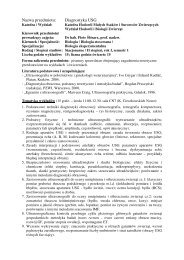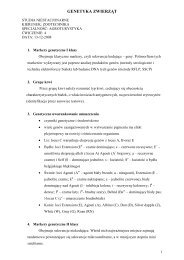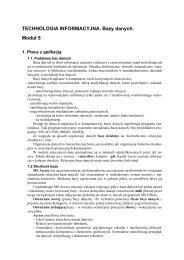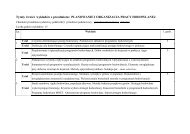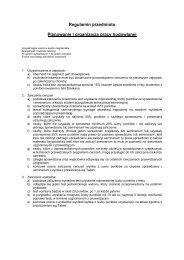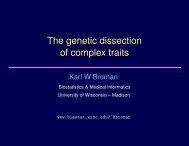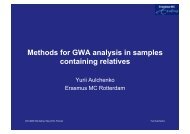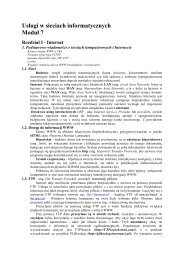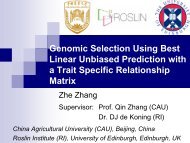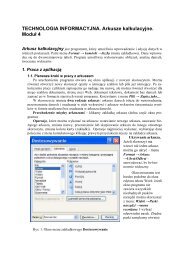The book of abstracts is available. - PoznaÅ
The book of abstracts is available. - PoznaÅ
The book of abstracts is available. - PoznaÅ
Create successful ePaper yourself
Turn your PDF publications into a flip-book with our unique Google optimized e-Paper software.
14 th QTL-MAS Workshop, Poznań University <strong>of</strong> Life Sciences, Poland 2010Pre-selection <strong>of</strong> markers for genome-wide selectionTorben Schulz-Streeck 1∗ , Joseph O Ogutu 1 , Hans-Peter Piepho 11 Bioinformatics Unit, Institute <strong>of</strong> Crop Science, University <strong>of</strong> Hohenheim, Fruwirthstrasse 23, 70599 Stuttgart,Germany∗ Presenting author: Torben Schulz-Streeck, email: torben.schulz-streeck@uni-hohenheim.deBackground. Accurate prediction <strong>of</strong> genomic breeding values (GEBVs) requires numerousmarkers. However, prediction accuracy can be enhanced by excluding markers with no effectsor markers with incons<strong>is</strong>tent effects among crosses that can adversely affect the prediction <strong>of</strong>GEBVs.Methods. We present three different approaches for pre-selecting markers prior to predictingGEBVs and assess the extent to which pre-selection <strong>of</strong> markers improves prediction accuracy.1. Testing each SNP using a linear regression model similar to Macciotta et al. (2009)2. Analyzing each SNP for cons<strong>is</strong>tency among crosses using mixed models3. Analyzing each SNP for cons<strong>is</strong>tency among generations using mixed modelsWe predicted GEBVs for the single quantitative trait in the common dataset provided for the14 th QTL-MAS workshop using four different BLUP methods, including ridge regression andthree geostat<strong>is</strong>tical models. Performances <strong>of</strong> the models were evaluated using four differentmodel selection criteria plus 5-fold cross-validation.Results and conclusions. Ridge regression and the geostat<strong>is</strong>tical models gave almost similarfits. Pre-selecting markers was evidently beneficial since excluding markers with incons<strong>is</strong>tenteffects among crosses increased the correlation between GEBVs and observed values invalidation datasets from 0.530 (using all markers) to 0.584 (using pre-selected markers).However, extension <strong>of</strong> the ridge regression model to allow for heterogeneous variancesbetween the n (n =5, 10, 50, 100, 250) most significant markers and the remaining markersonly marginally increased the accuracy <strong>of</strong> prediction (from 0.584 to 0.587).Results produced using models selected by AIC and GCV were nearly cons<strong>is</strong>tent with thosefor models selected by the 5-fold cross-validation, implying that model selection criteria suchas AIC and GCV may be used instead <strong>of</strong> cross-validation to reduce computing time.We submit results from the following two final models:1. Linear spatial model with the 1000 most significant markers selected by method 22. Ridge regression with the 1000 most significant marker selected by method 2 andheterogeneous variance between the 50 most significant markers and the remainingmarkersMacciotta NPP, Gaspa G, Steri R, Pieramati C, Carnier P, Dimauro C: Pre-selection <strong>of</strong> most significant SNPSfor the estimation <strong>of</strong> genomic breeding values. BMC Proc 2009, 3(Suppl 1):S1435



